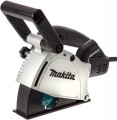Working discs / cutters
The largest number of discs or cutters (see "Work item") that can be installed on the tool at the same time. However, cutters are used only
one at a time — this is due to their technical features. But several disks can be installed at once — usually
2, less often
3 or more.
The "repeated" tool is very useful for situations where you need to cut a wide furrow — wider than the thickness of the disc. With one disc, two passes would have to be made for this (along one edge of the furrow and along the second), and besides, manually control the parallelism of both slots. 2 or 3 disks allow you to cope with the task in one pass, and you do not need to monitor parallelism — the distance between the slots remains unchanged anyway. This distance can usually be adjusted; see "Working Width" for details.
Real power
The power delivered by the tool motor directly to the cutter or blade. The output power is inevitably less than the power input of the motor.
Note that in the characteristics of tools this parameter is given relatively rarely. However, it is he who most accurately describes the general capabilities of the unit, such as speed, the ability to make deep cuts and cope with hard materials. Therefore, it is best to compare different models with each other precisely in terms of output power.
This indicator also allows you to evaluate the overall efficiency: the higher the ratio of output power to the power consumption of the engine, the more efficiently the tool consumes energy / fuel.
Power consumption
Power consumed when operating an electric tool (see “Type”). Essentially, this is the power of the electric motor installed in the tool.
This indicator primarily determines electricity consumption and connection requirements. Thus, devices with a power of up to 3.5 kW can operate from a regular 230 V outlet; at higher values, as a rule, a connection to a 400 V network is required.
Also, based on power consumption, the general capabilities of tools are often assessed and compared - operating speed, ability to cope with hard materials, etc. Technically, this is not entirely true, since such characteristics depend not on the consumed, but on the useful power (see above). However, the latter is indicated relatively rarely in the characteristics, and the difference in energy consumption most often more or less corresponds to the difference in output power. So it is quite possible to say that the
higher the power consumption, the “stronger” the tool as a whole, the greater the cutting depth and operating speed it can provide, and the better suited for hard materials.
Rotation speed
The maximum speed of rotation of the disk / cutter provided by the tool.
The higher the speed, the higher the speed of the cutting edge relative to the material, the higher the processing speed and the more accurate the cut is. On the other hand, as the speed increases, the torque decreases. So for the same blade/cutter diameter, higher RPMs will be beneficial on relatively soft materials, while a slower tool will be better for hard and stubborn materials.
Processing width
The width of the furrow that the tool can cut. This parameter is relevant for models with a cutter (see "Work item") and units with several discs (see "Working discs / cutters"). In the first case, the processing width corresponds to the width of the cutter, in the second — to the distance between the discs. This distance can be changed by installing special washers on the spindle; therefore, in many tools, the processing width is indicated by a range, from minimum to maximum.
Processing depth
The depth to which the tool can cut through the material. This characteristic is directly related to the diameter of the blade / cutter (see above) — for
greater depth, a larger diameter is required. However, units with the same working element size may differ in the depth of processing due to the difference in engine power and some design features.
In many models, the depth can be adjusted; for such devices, the minimum and maximum depth values \u200b\u200bare indicated in the characteristics.
Cable length
The length of the network cable can tell you how far from the outlet you can operate the device. Therefore, for domestic use, it is more relevant to choose models with a short cord, for construction work or use in production, in the garage a longer cable is better.
Noise level
Approximate noise level produced by the instrument during operation (actual volume may vary depending on performance).
The lower the noise, the more comfortable the use of the tool, the easier it is to work with it without headphones or other noise protection equipment. It is easiest to evaluate a specific volume level using comparative tables. In general, wall chasers and jointers are quite noisy equipment — in most models, the volume exceeds 90 dB (loudness comparable to the sound of a moving freight car at 7 m), and in the most noisy this figure reaches 118 – 119 dB, which is only slightly below the human pain threshold . If the volume is more than 100 dB, it is highly recommended to use protective headphones or earplugs.

